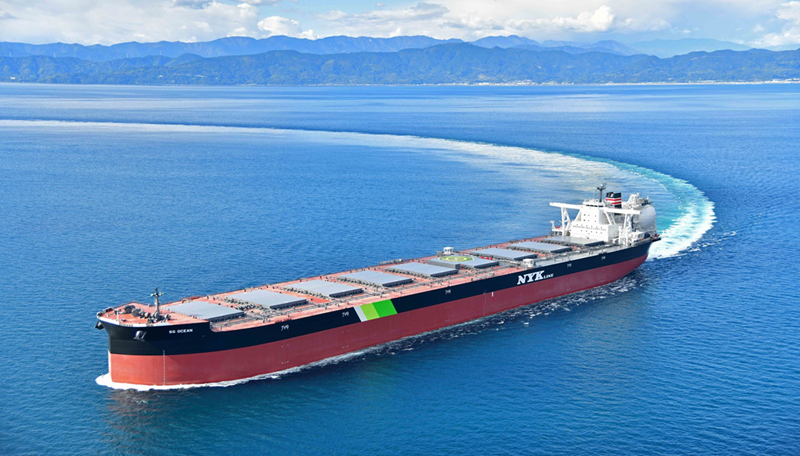NYK Takes Delivery of Japan’s First LNG-Fueled Capesize Bulk Carrier

Decarbonizing JFE's Supply Chain
A naming ceremony was held on January 30 for an LNG-fueled capesize bulk carrier that was ordered by NYK and will be deployed to transport iron ore and coal from Australia to Japan under a long-term consecutive voyage charter contract with JFE Steel Corporation (JFE). The ceremony was held at Japan Marine United Corporation's Tsu Shipyard in Mie Prefecture. The vessel is the first capesize LNG-fueled bulk carrier to be built at a shipyard in Japan (according to an NYK research). NYK is expanding its fleet of LNG-fueled vessels to meet the NYK Group's goal of reducing GHG emissions by 45% from fiscal 2021 levels by fiscal 2030 while taking on the challenge of decarbonizing an entire supply chain.
The vessel was named “SG Ocean” to reflect the "SG" of NYK's "Sail GREEN" brand, which emphasizes reducing GHG emissions through the transport of goods and contributing to the eco-friendly supply chains of customers, and the image of a vessel sailing majestically in the open ocean while protecting the environment. The naming ceremony was attended by Koji Kakigi, president and CEO of JFE Holdings, Inc., and Takaya Soga, president of NYK, among others.
By utilizing LNG-fuel, the vessel will emit approximately no sulfur oxides (SOx), 75% less nitrogen oxide (NOx), and 25% less carbon dioxide (CO2) compared to existing conventional heavy-oil-fueled vessels. Additionally, the vessel will be compliant with the IMO’s NOx emission regulations (Tier III).* The vessel uses the latest 7X62DF-2.1 iCER dual-fuel slow-speed diesel engine by WinGD, a world-class marine engine design company. This engine halves methane emissions when using LNG fuel. In addition, due to careful consideration of the equipment and arrangement of the LNG fuel tank and LNG fuel supply system, this ship will maintain the loadable quantity and cargo hold capacity of conventional bulk carriers of the same size despite the increased weight of additional equipment.
Outline of vessel
Length overall: 299.9 meters
Breadth (moulded): 50.00 meters
Draft (scantling): 25.00 meters
Deadweight tonnage: 210,000 tons
Contractor: Japan Marine United Corporation
* Capesize refers to bulk carriers having a deadweight tonnage of 120,000 tons or more. Ships between 60,000 tons and 120,000 tons are Panamax carriers.
** NOx emission regulations (Tier III)
The IMO-adopted MARPOL Convention is the main international convention covering the prevention of the pollution of the marine environment by shipping. In line with MARPOL Annex VI (Regulations for the Prevention of Air Pollution from Ships) that came into effect on May 19, 2005, NOx emission controls (Tier I controls) for diesel engines installed on vessels were implemented in Japan. Later the convention was revised, and a new NOx emission level (Tier II controls) came into force on July 1, 2010. The revised regulation is a very strict one that aims to decrease NOx emission levels by a further 20 percent from that of the first regulation. Moreover, a third control was adopted in 2008, targeting vessels constructed from 2016 and limited to emission control areas, to seek the reduction of NOx emissions by about 80 percent from that of the first tier.
